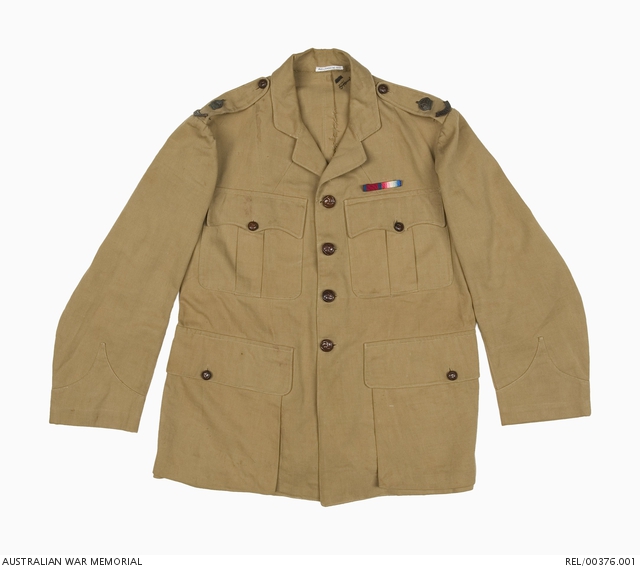| Places | |
|---|---|
| Accession Number | REL/00376.001 |
| Collection type | Heraldry |
| Object type | Uniform |
| Physical description | Cotton drill, Leather, Oxidised brass |
| Maker |
Unknown |
| Date made | pre 1919 |
| Conflict |
Period 1910-1919 First World War, 1914-1918 |
Service dress tunic : Major A Chisholm, 1 Light Horse Brigade, AIF

Australian Light Horse officer's light khaki cotton drill single breasted tunic. There is a seam from the top pocket to the collar. The shoulder straps are secured at the collar end with a small pressed leather button, and have the rank insignia of major which is an oxidised brass Imperial crown with red velvet. There is also a curved voided 'AUSTRALIA' shoulder title in oxidised brass. Both the shoulder badges are held in place with a split pin. The tunic has an open (step) collar and has four large pressed leather buttons. The two breast pockets have a three-pointed scalloped flap, secured by a small pressed leather button, and have a central box pleat. The larger lower patch pockets have a straight flap secured with a small pressed leather button and expandable sides. There is a single rear vent. The cuffs are pointed. The tunic is unlined. The ribbon bar above the left breast pocket represents the award of the Distinguish Service Order and the 1914-15 Star. The brown leather used for the buttons has been pressed to imitate plaited leather. The buttons are held on by small brass rings and are removable. Above the left breast pocket is a ribbon bar which represents the award of the Distinguished Service Order and the issue of the 1914-15 Star.
Worn by Major (later Lieutenant Colonel) Alexander Chisholm, DSO, OBE, VD.
Chisholm (1878 - 1945) was born in Brisbane and joined the 13th Light Horse Regiment, Queensland Mounted Infantry until the outbreak of World War 1. He then joined the AIF as a lieutenant on 20 August 1914. Chisholm was appointed to 2nd Light Horse Regiment (LHR) but transferred to 1st LHR while serving on Gallipoli in August 1915. From this date until October 1915, he was the Adjutant for the 1st LHR. He served at Quinn's Post and Pope's Hill until the evacuation of the Australian troops in December 1915. He was appointed Brigade Major of 1st Light Horse Brigade in March 1916. Chisholm was involved in operations in Egypt, Sinai and Palestine, taking part in the battles of Romani, Katia and Bir-el-Abd before being promoted to major on the 2nd September 1916. The 1st LHR, as part of the Egyptian Expeditionary Force defeated the Turks at Magdhaba and Rafa. Chisholm was engaged in the fighting during the second battle of Gaza and the capture of Beersheba. On the 1st January 1918 he was awarded the Distinguished Service Order, 'relating to conspicuous services rendered..' He was also mentioned in dispatches three times.
Chisholm was severely wounded in action in the chest on 11th April 1918 at Musallabeh. Due to his injury he served as an General Staff officer with the 1st LH Australian Mounted Division until his demobilisation on August 1919.
He returned to Australia on 26 July 1919. Between 1921 and 1924 and as Lieutenant Colonel, he commanded 5 LHR (militia) in Queensland. He was appointed OBE in 1939 for his contribution to military and social services. He died in 1945 in a car accident.
- Mess waistcoat : Lieutenant A Chisholm, 13 Light Horse Regiment (Queensland Mounted Infantry)
- Service dress tunic : Lieutenant Colonel A Chisholm, 5 Light Horse Regiment, AIF
- Mess jacket : Lieutenant A Chisholm, 13 Light Horse Regiment (Queensland Mounted Infantry)
- Mess trousers : Lieutenant A Chisholm, 13 Light Horse Regiment (Queensland Mounted Infantry)
Related information
Conflicts
Places
Subjects
Related Objects
- Service dress tunic : Lieutenant Colonel A Chisholm, 5 Light Horse Regiment, AIF
- Mess jacket : Lieutenant A Chisholm, 13 Light Horse Regiment (Queensland Mounted Infantry)
- Mess trousers : Lieutenant A Chisholm, 13 Light Horse Regiment (Queensland Mounted Infantry)
- C. 1917. PORTRAIT OF MAJOR ALEXANDER CHISHOLM, DSO, BRIGADE MAJOR, 1ST AUSTRALIAN LIGHT HORSE ...
- Probably PALESTINE, 1918-05-21. CAPTAIN HARRINGTON (MILITARY GOVERNOR), MAJOR ALEXANDER CHISHOLM, ...
- Mess waistcoat : Lieutenant A Chisholm, 13 Light Horse Regiment (Queensland Mounted Infantry)